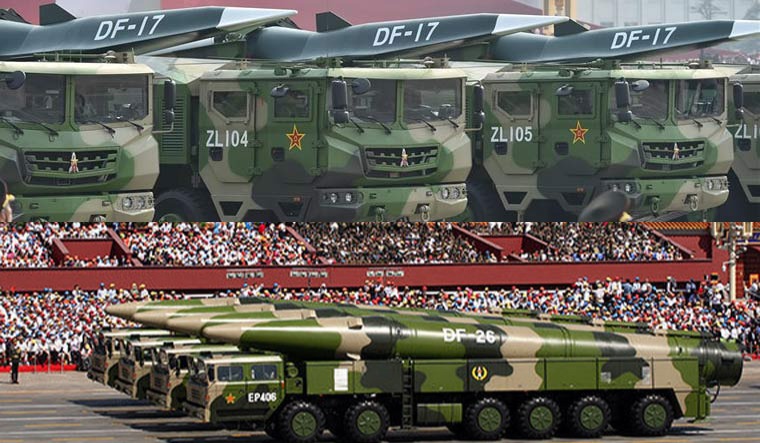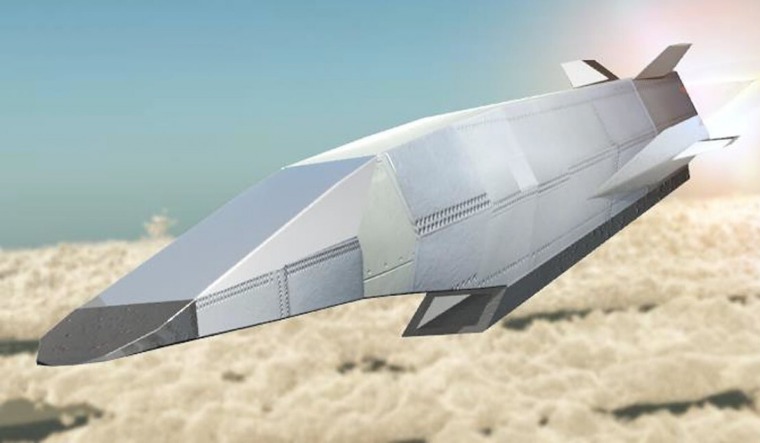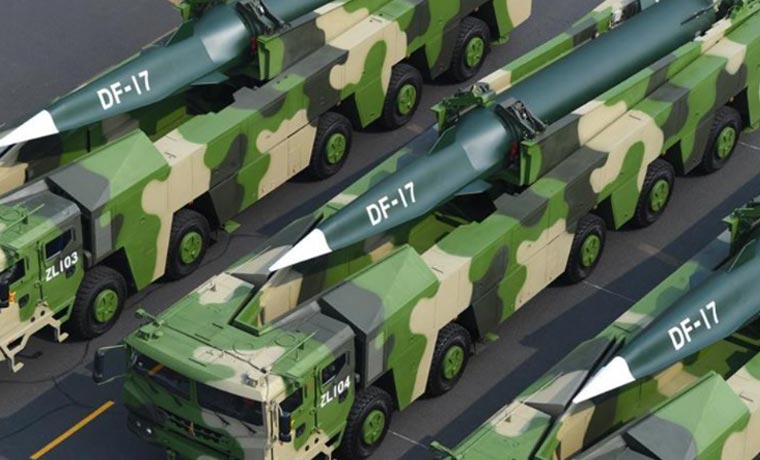Since mid-October, hypersonic weapons have occupied considerable space in global headlines. On October 16, the Financial Times reported that China had tested a new hypersonic missile that circled the globe before hitting its target.
The news triggered shock in sections of the US strategic establishment, with some calling the test another "Sputnik moment". The reference was to the shock the West experienced when the Soviet Union sent the first man-made object into orbit in 1957.
Amid the frenzied news coverage, speculation on what system was tested and the inevitable obfuscation and denials from China, there is still confusion on what hypersonic weapons are.
Understanding the nature of hypersonic weapons lays the foundation to know how they are distinct from existing categories of weapons and why they are deadlier for specific roles.
Most advanced militaries use two types of missiles for surface-to-surface roles, that is, to attack targets on land or at sea.
Ballistic missiles, as the name suggests, are warheads mounted on rockets that are launched on an unpowered ballistic (parabolic) trajectory that arch upward before descending to their targets. Ballistic missiles generally have very high speed (several times the speed of sound) as they descend to their targets, but have lower accuracy. Thus they are typically preferred for attacking large targets or for carrying nuclear warheads.
Cruise missiles, again as the name suggests, "cruise" to their targets through the atmosphere. They are essentially unmanned aircraft powered by miniature jet engines. Such missiles typically have lower speeds than ballistic missiles, but higher accuracy—as they can mount a range of guidance systems like terrain reference equipment, GPS and radar homing, and can manoeuvre in flight to avoid detection by radar.
Hypersonic weapons comprise a third category that is characterised by high speeds, which are typically over five times the speed of sound when moving through the atmosphere. Hypersonic weapons currently in development by various nations are of two types:
1. Hypersonic glide vehicles (HGVs), which are launched by a ballistic missile and glide to their targets
2. Hypersonic cruise missiles that are powered by high-speed, air-breathing jet engines called scramjets.
While almost as fast as ballistic missiles, hypersonic weapons are distinct in the fact that they can manoeuvre to their targets. This enables them to not only have a better chance at evading defences such as surface-to-air missiles but also makes it harder for radars to track them. Western analysts have warned China and Russia could use hypersonic weapons to defeat the US’s ground-based network of early-warning radars.
Vice-Chairman of the Joint Chiefs of Staff and former commander of U.S. Strategic Command General John Hyten explained hypersonic weapons are “responsive, long-range, strike options against distant, defended, and/or time-critical threats…”. In addition, their high speed gives hypersonic weapons considerable kinetic energy and destructive power, negating the need for large warheads.
The concept of time-critical threats is a valid point.
Proponents of high-speed surface-to-surface missiles point to the failed US attack against Osama Bin Laden in Afghanistan in 1998. Then, the US Navy launched Tomahawk cruise missiles, which fly slower than the speed of sound, from ships and submarines against locations linked to al-Qaeda. The flight time from the Arabian Sea over Pakistan took tens of minutes, allowing Osama Bin Laden ample time to flee. A hypersonic weapon, employed in a similar role, would have taken a handful of minutes, at most.
Eminent strategic affairs analyst Bharat Karnad told THE WEEK that hypersonic weapons are “weapons of choice in the future, once the technology matures and is fully militarised”.
He explained, “This is because of speeds they attain in flight in excess of Mach 7—seven times the speed of sound, or 2.4 km per second—which makes them virtually uninterdictable and, hence, nearly impossible to defend against.”
In an interview with CBS in November, Hyten warned China's progress in hypersonic weapons meant Beijing could have the capability to launch a nuclear first strike on the US. In the same interview, Hyten claimed that in “the last five years, China has carried out hundreds of hypersonic tests, while the U.S. has conducted just nine”. Russia too has been testing hypersonic weapons, notably the Zircon, a ship- and submarine-launched hypersonic cruise missile.
 A collage showing DF-17 hypersonic glide missiles and ballistic missiles of the Chinese military
A collage showing DF-17 hypersonic glide missiles and ballistic missiles of the Chinese military
In 2019, China displayed a hypersonic glide vehicle designated the DF-17 at a military parade, leading experts to believe the weapon was in service with the People’s Liberation Army (PLA). The DF-17 is mounted atop a ballistic missile. According to US intelligence estimates, the DF-17 has a range of around 2,500km and moves at between five and 10 times the speed of sound. US experts have postulated that the DF-17 could be equipped with either conventional or nuclear warheads. They have also expressed concern China could develop a variant of the DF-17 meant to target aircraft carriers at sea.
Karnad was more guarded about China's advances. He noted, “Because nothing is transparent about China and even less its missile programmes, it is hard to judge just what's happening. There's a difference, however, between testing and having a usable weapon system and that's where most hypersonic vehicle projects in the most advanced countries are at.”
Are hypersonic weapons invincible?
 Concept for Japan's hypersonic weapon | Japan's Acquisition, Technology & Logistics Agency
Concept for Japan's hypersonic weapon | Japan's Acquisition, Technology & Logistics Agency
Despite the technological advances, several experts are not convinced about China's advances. They attribute their cynicism in part to the technological challenges in developing weapons that can travel through the atmosphere at great speeds.
These challenges include the problem of overheating on the hypersonic vehicle's surface due to the high "drag" (the resistance caused by the air), which could also potentially affect its manoeuvrability and hinder its guidance system (e.g., GPS), by blocking communication with satellites.
But like all things in warfare, weapon developers are attempting to address these challenges. In October, South China Morning Post, a Hong Kong-based publication, reported PLA scientists were mulling the use of artificial intelligence systems to update the software of a hypersonic weapon's flight controls, in flight. This would reduce the possibility of degradation of its accuracy after its launch.
The India angle
Much of the discourse on hypersonic weapons has been coloured by the realm of superpower politics: How will they change the balance of power between the US, Russia and China? Relatively less has been written about how hypersonic weapons are a threat to India.
In September last year, the DRDO announced it had tested a hypersonic technology demonstrator vehicle (HSTDV), which could provide information to design hypersonic missiles and reusable space vehicles. The HSTDV used an indigenously developed scramjet engine. There have also been declarations by India and Russia to develop the BrahMos II, a hypersonic weapon, using the same cooperation framework that led to the creation of the BrahMos supersonic cruise missile.
But India’s hypersonic technology ventures remain very much a work in progress. Pravin Sawhney, a former Indian Army officer and founder-editor of Force magazine, was forthright. Sawhney told THE WEEK “We [India] have nothing (hypersonic weapons) and we will not have anything for the next 10 years at least… And 10 years is a very optimistic window.” Sawhney referred to the difficulties the DRDO has faced in developing the Nirbhay, a subsonic cruise missile.
Are there any countermeasures?
On November 19, the US Missile Defense Agency announced Lockheed Martin, Northrop Grumman and Raytheon Missiles and Defense had been selected to design a surface-to-air missile that could intercept hypersonic glide vehicles. The weapon is meant to be fired from the US Navy's destroyers that are equipped with the Aegis battle management system.
Recently, Russian officials claimed they saw India as a prospective customer for the new S-500 surface-to-air missile system that they touted could shoot down hypersonic missiles and satellites.
Karnad referred to other technologies. “Hypersonic weapons everywhere are in the process of being developed alongside their antidote—counter-technologies such as lasers and directed-energy weapons, which are at the experimental stage,” he explained. Directed-energy weapons damage or destroy targets using focussed energy by means of lasers, microwaves or particle beams.
However, Sawhney noted no country has countermeasures against hypersonic weapons currently.
Sawhney explained the foremost challenge in dealing with hypersonic weapons was in detecting them early. He said the US and China were contemplating the development of a ‘grid’ of satellites in low-earth orbit (LEO) that would be better placed to detect and track high-speed weapons.
In addition, prospective capabilities, such as high-powered laser beams, are still in development. Sawhney pointed out that current laser weapons have power levels in the tens of kilowatts, which is just sufficient to 'fry' the guidance systems of slow-flying drones. A laser system would need power in the range of hundreds of kilowatts to, in theory, be able to target hypersonic weapons. No country is believed to have a laser weapon with such a high degree of power that can be deployed in a conflict zone.
Earlier this year, Defense News reported the DRDO was working on the concept of a 100KW laser system dubbed DURGA II (Directionally Unrestricted Ray-Gun Array), though little information is available on it.
How should India react?
China’s pursuit of hypersonic weapons is in concert with the People’s Liberation Army’s larger focus on "disruptive" technologies such as artificial intelligence and cyber warfare. A US government report noted Chinese cyber attacks against India had risen since the standoff in Ladakh started last year. But has India’s security establishment taken note of the disruptive nature of the Chinese threat, holistically?
For instance, much has been written on the potential of the Russian S-400 air defence system India will begin inducting soon. The S-400 is already in service with the PLA. Will the Indian S-400 be facing merely Chinese fighter jets or a combination of fighters, smart drones, electronic warfare attacks and hypersonic weapons? The latter combination of threats has not been seen in combat, yet.
Sawhney argued China’s hypersonic weapons were not a threat that concerned the US only, warning the technology could be used against India. He declared “India was three generations behind in technology and how to fight a war”.
A generation, in terms of military technology, was 10 years.
He called for India to have a “proper technology roadmap” on what kind of warfighting capability the country needed, instead of countering individual threats such as hypersonic weapons or drones.
“If you remain fixated on Pakistan, it will not work against the PLA, an extremely superior power,” Sawhney noted.





